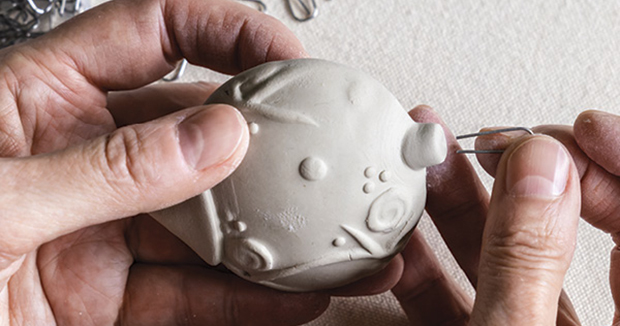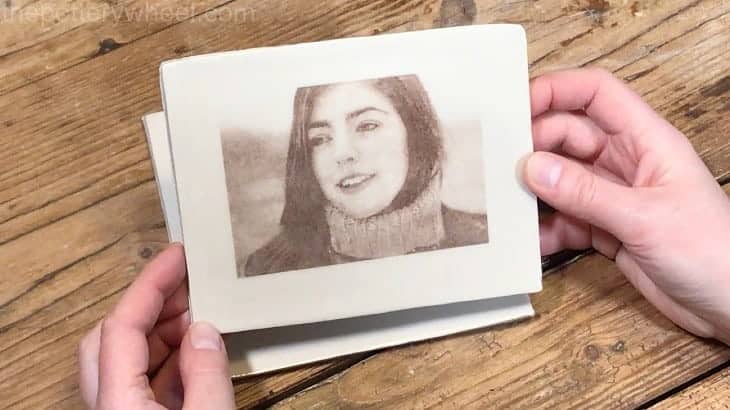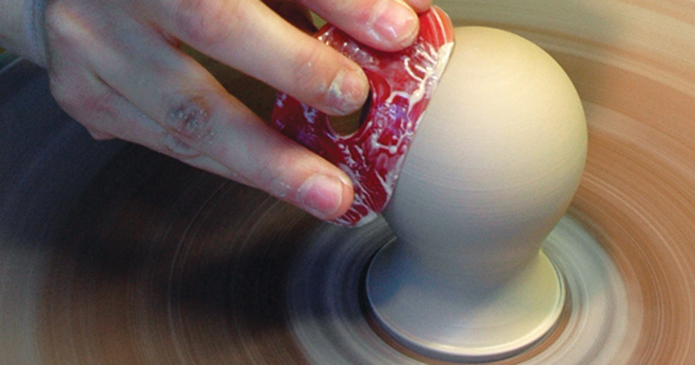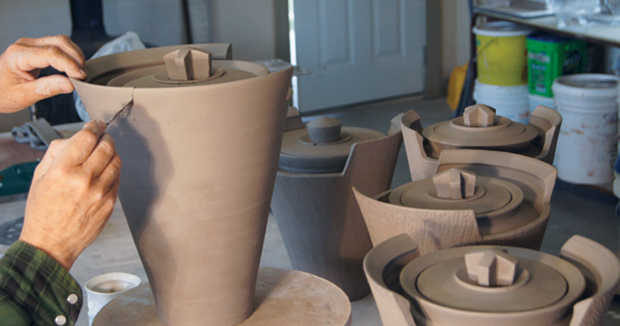

I believe that most potters and ceramic artists will agree, the holidays present a wonderful opportunity to create special, fun, and festive pieces that would not normally appear in our everyday repertoires. Ceramic ornaments have become very popular in recent years and many of us have tried our hand at our own unique creations. After several attempts, I have come up with a slab-built version with a bit more dimension.
My own personal style of decorating involves textures, stamping, and slip dots. Each is finished with transparent, colored glazes and, sometimes, lusters. This ceramic ornament can be decorated in any way you wish to suit your unique artistic style.
Forming the Body
Begin by rolling out a ⅛-inch-thick slab using a dowel on each side of your clay for even thickness (1). When rolling such thin slabs, it is helpful to start with a thicker dowel size and reduce the thickness gradually. I normally start with ⅜-inch thickness and proceed to reduce the thickness in several stages. Tip: Remember to flip and turn your slab as you go, which will help to prevent unevenness and warping in your finished piece. Using ⅛-inch-thick slabs keeps the finished piece as light as possible so that it won’t weigh down a tree branch.
If you are more comfortable using a thicker slab, you will still be able to achieve excellent results using 3/16- or ¼-inch-thick slabs. It is important to smooth each side of your slab with a metal or rubber rib in order to smooth the clay particles.
This will also remove any canvas texture from the slab.




Next, add decorative texture to the slab, if desired, using stamps, texture plates, fabric, lace, etc. The textures that I use come from my own designs. I create stamps and rollers of all sizes, from the same clay body that I use for my finished work,
which are then bisque fired. I often create large texture plates from these smaller stamps. I begin with a slab that is rolled to at least ⅜-inch (and up to 7/16 inch) thick. I then impress the slab with a collection of smaller stamps to create patterns. These larger slabs are dried slowly between two sheets of drywall board to alleviate warping. I like the idea that all of the patterns and textures that I use come from my own imagination and fit together like a family. I also enjoy being able to make stamps specific to the project that I am working on, such as a mandala design for a round clay ornament and so on.
Cut two circles for each clay ornament using a metal circle cutter or a paper template (2, 3). For this project, I have used a cutter measuring 7 cm in diameter. If you do not already have one, a good set of stainless-steel round cutters (typically used in the kitchen for baking) is a very good investment for handbuilders.




Take each circle and form it into a curve by pressing it firmly yet gently over a sphere-shaped object covered with plastic wrap (4). Depending on the size of the circle, you may use such items as a tennis ball, golf ball, the end of a light bulb or whatever else you may have on hand. Allow the formed pieces to stiffen to medium-hard, leather hard. I place the pieces in a damp box overnight at this stage.

Once the two halves are firm enough to handle without distorting the shape, use a Surform around the rims to create flat edges that will perfectly fit together, then score the flat edges (5).
Join the two halves together using slip or Magic Water (6). My preference for handbuilding is Magic Water, which I find cleaner and easier to use than slip. If you are using Magic Water, use a paintbrush to apply it to the scored rim of each piece, using the brush to work it into a thin slip without over wetting. Join the two halves together and compress the joined edges using fingers and/or a pony roller (7), then smooth the seam with a rubber rib.
Pierce a small pinhole to allow air to escape as the clay ornament dries and shrinks (8). Place the piece back into the damp box for at least a few hours or overnight to allow the moisture content to equalize throughout the piece. In the meantime, roll out a few small coils (approximately 1 cm in diameter) which will later be cut into short pieces and used to top the ornament and receive the wire hanger. Place the coils in the damp box along with the ornament.
From the coil that you rolled earlier, cut a small piece (approximately 1 cm in length). Cut a notch into one end (9) and attach the notched end to the top of the ceramic ornament. Insert a high-temperature wire hanger (10). The ones that I like to use are purchased as pre-cut and shaped high-temperature ornament wires from Amazon.




Carol Harris is a ceramic artist, living in the Comox Valley of British Columbia, Canada. She has been working with clay for 30-plus years. To see more of her work, visit her website carolharrisceramics.com or Instagram @carolharris9111.






